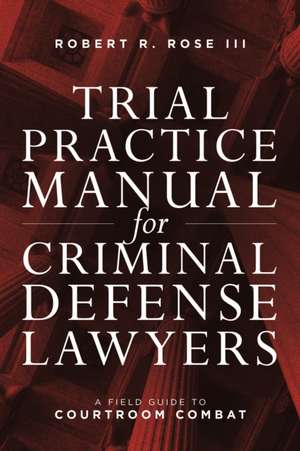TRIAL PRACTICE MAN CRIMINAL DEFENSE LAW
Autor Robert R Rose IIIen Limba Engleză Carte – 6 iul 2021
Learn how to represent the "unrepresentable" by respecting your client, using your fear to your advantage, telling the jury the truth about the weaknesses of your case, and building trust relationships with jury members that enable them to advocate for your client during deliberations.
Robert Rose will teach you how to become a warrior and win more of your trials than you ever thought possible. Discover how to take charge of the courtroom by standing up for your clients and telling their story in a new and compelling way.
Preț: 421.39 lei
Preț vechi: 519.32 lei
-19% Nou
Puncte Express: 632
Preț estimativ în valută:
80.63€ • 84.40$ • 67.11£
80.63€ • 84.40$ • 67.11£
Carte indisponibilă temporar
Doresc să fiu notificat când acest titlu va fi disponibil:
Se trimite...
Preluare comenzi: 021 569.72.76
Specificații
Notă biografică
By Robert R. Rose, III
Cuprins
Prefacexv
Acknowledgmentsxvii
Introductionxxi
Why We Do What We Doxxi
1Introduction and Overview1
A.Dealing with Fear6
B.Always Tell the Truth8
C.Integrity11
2Getting Started19
A.Getting Familiar with Your Case19
B.Private Attorneys and the Fee Agreement21
C.Public Defenders23
D.Meeting the Client24
E.Investigation28
1.Private Attorneys30
2.Public Defenders30
3Arraignment in the Lower Court (Misdemeanors Only)31
A.Initial Appearance (Felony)32
B.Preparing the Client for a Guilty Plea (Misdemeanor)32
C.Re-Arraignment33
4Trial in the Lower Court (Misdemeanors Only)35
A.Bench Trial35
B.Jury Trial37
5Preliminary Hearing39
A.Preparation42
B.Motions44
C.Dismissal of Charges45
D.Should the Defense Present Evidence?46
E.Adjusting Bond47
F.Closed Hearings48
G.Discovery49
6Representation Before the Grand Jury51
A.Initial Appearance in the Lower Court (Felony)53
7Arraignment in District Court55
A.Preparing the Client for a Guilty Plea56
B.The Conditional Guilty Plea59
C.The Non-Resident Client59
8Discovery61
A.From the State61
B.From the Defense65
9Motion for Mental Evaluation67
10Preparing Your Case for Trial71
A.Generally71
B.The Theory of the Case and the Case Theme73
C.Jury Instructions76
D.Witnesses77
1.Deposing Witnesses77
2.Expert Witnesses78
E.Evidence81
1.DNA Evidence82
2.Demonstrative Evidence84
F.Plea Negotiations and Agreements85
G.The Proffer and Proffer Letter88
H.The Pretrial Memorandum92
I.Briefs, Motions, and Deadlines94
1.Motions in Limine97
2.Rule 404(b) Motions and Motions to Suppress Evidence97
J.Working with the Prosecuting Attorney99
K.Working with the Court101
L.Continuing the Trial102
11Setting the Stage105
A.Dealing with the Press106
B.Dealing with a Hostile Court107
C.Using Computers and Audio/Video Equipment108
12Voir Dire111
A.Voir Dire in Federal Court112
B.Overview112
C.The Rules116
1.The First Rule of Voir Dire: Know the Law116
a.Challenges for Cause120
2.The Second Rule of Voir Dire: Know the
Philosophy121
a.Voir Dire and the Defense Attorney122
b.Accepting the Jurors as They Are122
c.How Jurors Feel128
d.Voir Dire Is Theater128
e.Revealing Our Fear131
f.The ¿Bad News¿ Juror133
g.The ¿Good News¿ Juror135
h.Understanding Jury Dynamics135
i.Juror Profiling137
j.Use of Hypotheticals138
k.Thanking the Jury139
3.The Third Rule of Voir Dire: Know the Technique139
a.Incorporating the Theory of the Case141
b.How to Start142
c.Have a Partner150
d.Don't Embarrass the Jurors151
e.Let the Jurors ¿Own¿ Your Theory of the Case154
f.Breaking the Ice¿Going First155
g.Challenging a Juror for Cause162
h.The Miracle of Silence167
i.The Sexual Assault Accuser170
j.Flexibility173
k.Know When to Shut Up180
l.Going ¿Off Road¿181
m.Individually Sequestered Voir Dire181
n.Final Thoughts181
13Opening Statement183
A.Use of ¿First Person¿188
14Cross-Examination189
A.Introduction189
1.Limitations on Lay Witness Testimony190
2.Opinions Regarding Truthfulness of a Witness
or Guilt of the Defendant190
3.Limitations on Expert Witness Testimony191
B.Generally191
C.The Rules195
1.Rule No. 1: You Become the Witness195
2.Rule No. 2: Leading Questions Only196
3.Rule No. 3: Short + Statements = Control197
D.Primacy and Recency200
E.The Big Question201
F.Know When to Shut Up202
G.Know When Not to Be Aggressive203
H.When a Witness ¿Runs¿204
I.Police Officers206
J.Expert Witnesses212
K.Being Held in Contempt214
15Impeachment217
A.Use of Inconsistent Statements218
1.Introduction218
2.Relevant Federal Rules of Evidence218
3.How to Use This Method219
4.What Is an ¿Inconsistent Statement¿?219
5.The General Rules of Impeachment with an Inconsistent Statement221
B.Contradictions¿Contrary Evidence230
1.Introduction230
2.Relevant Federal Rules of Evidence231
3.How to Use This Method231
C.Motivation235
1.Introduction235
2.Relevant Federal Rules of Evidence235
3.How to Use This Method236
4.The Deal237
5.The Arresting Officer/The Lead Investigator240
D.Truthfulness244
1.Introduction244
2.Relevant Federal Rules of Evidence244
3.How to Use This Method245
E.Convictions247
1.Introduction247
2.Relevant Federal Rules of Evidence248
3.How to Use This Method248
F.What the Witness Could Have Done
but Did Not Do251
1.Introduction251
2.Relevant Federal Rules of Evidence252
3.How to Use This Method252
G.Capacity256
1.Introduction256
2.Relevant Federal Rules of Evidence256
3.How to Use This Method256
4.Other Opportunities to Impeach257
H.Prior Bad Acts¿404(b)258
1.Introduction258
2.Relevant Federal Rules of Evidence259
3.How to Use This Method260
I.Habit261
1.Introduction261
2.Relevant Federal Rules of Evidence261
J.Writing Used to Refresh Memory261
1.Introduction261
2.Relevant Federal Rules of Evidence262
3.How to Use This Method262
K.Admissions264
1.Introduction264
2.Relevant Federal Rules of Evidence264
3.How to Use This Method264
4.F.R.E. 801(d)(2)(E) and the Admissibility of Co-Conspirator Statements265
L.The Hearsay Declarant267
1.Introduction267
2.Relevant Federal Rules of Evidence268
3.How to Use This Method268
M.Character Witnesses270
1.Introduction270
2.Relevant Federal Rules of Evidence272
3.How to Use This Method272
4.The Problem with Character Evidence for
the Defendant274
5.Teaching Points278
a.Question No. 1¿The Prior
Shaking Incident278
b.Question No. 2¿The Animal
Control Report279
N.Victims of Sexual Assault279
1.Introduction279
2.Relevant Federal Rules of Evidence280
3.How to Use This Method283
O.Experts¿Qualifications and Curriculum Vitae283
1.Introduction283
2.Relevant Federal Rules of Evidence284
3.How to Use This Method284
P.Experts¿Learned Treatises286
1.Introduction286
2.Relevant Federal Rules of Evidence287
3.How to Use This Method287
16Putting on the Defense Case289
A.Motion for Judgment of Acquittal289
B.Direct Examination of Your Witnesses290
C.Direct Examination of Your Expert293
D.Direct Examination of Your Client295
E.Preparing Your Witnesses for Cross-Examination298
F.Resting Your Case301
G.The State's Rebuttal Evidence301
H.Objections302
1.Forms of Objections304
2.Offer of Proof306
17The Home Stretch307
A.Jury Instruction Conference307
B.Closing Argument308
C.Jury Nullification311
D.Jury Questions during Deliberations311
E.Ex-Parte Communication Between Jurors
and the Court312
F.The Verdict314
G.Mistrial316
H.Adjusting Bond318
18Preparing for Sentencing319
19Postconviction Motions321
20Appeal323
A.Everything Is on the Record324
B.Stand Your Ground325
C.Setting Up the Appeal325
D.¿The Big Five¿326
E.Standards of Review327
1.De Novo327
2.Sufficiency of the Evidence328
3.Abuse of Discretion328
4.Harmless Error328
5.Plain Error328
6.Ineffective Assistance of Counsel329
7.Prosecutorial Misconduct330
21Parting Thoughts331
Index333
